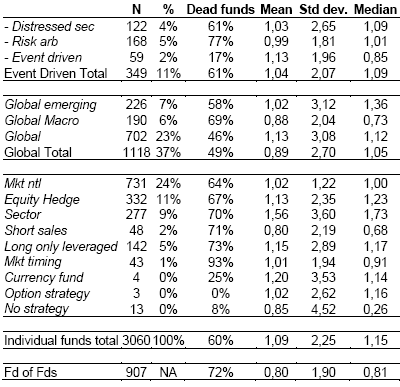Market conditions vary considerably across the business cycle, presumably affecting the opportunity set for a given investing style/strategy. What are the return characteristics that predict which hedge funds can best navigate changing economic conditions? In his 2007 paper entitled “The Sustainability of Hedge Fund Performance: New Insights”, Daniel Capocci decomposes hedge fund returns to determine how investors can reliably identify funds that outperform equity and bond indexes in both bull and bear markets. Using monthly return data for the 1994-2002 business cycle from two sources (3,060 individual funds and 907 funds of funds) to investigate 14 potentially useful persistence discriminators, he concludes that:
- Most types of hedge funds outperform equity and bond indexes during the sample period. (Reference the table below.) Some lean toward value, and some toward growth. Many exploit momentum.
- An investor could not outperform major market indexes by switching each year to the previous year’s top hedge funds.
- However, low-volatility funds tend to outperform both other funds and major market indexes consistently and significantly. Measures that effectively incorporate return volatility include Sharpe ratio (higher is better), standard deviation (lower is better) and beta (lower is better).
- An investor could beat the indexes by switching each year to the funds with the best risk-return characteristics over the past three years. However, the difficulty of exiting hedge funds is a substantial barrier to implementing such a strategy, and poor (self-reported) data represents a risk in analyzing hedge funds.
- Results hold across the full market cycle of the entire sample period and in bull and bear subsamples separately.
The following table, excerpted from the paper, summarizes key return statistics across all hedge funds in the sample by fund strategy and in aggregate for 1994-2002. “Dead funds” is the mortality rate of funds for the entire sample period. The last three columns provide the mean return, standard deviation of returns and median return on a monthly basis by fund type. For example, of the 731 market neutral (Mkt ntl) funds in the sample, 64% (468) cease operations during the sample period. These 731 funds generate a mean (median) monthly return of 1.02% (1.00%), with a 1.22% standard deviation of monthly returns. This type has the lowest volatility. Sector funds generate the highest mean monthly returns, but with relatively high volatility.

In summary, low volatility of returns is key to identifying persistent outperformance among hedge funds.